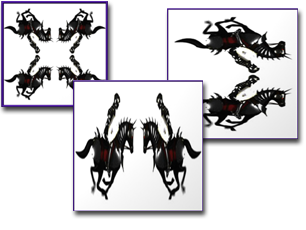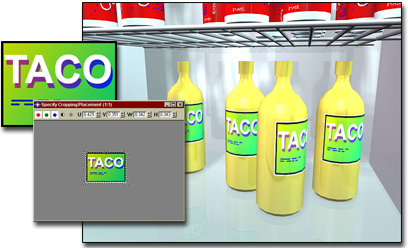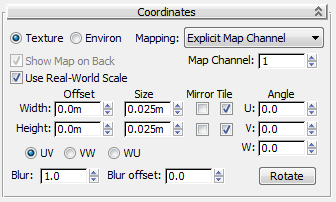On the Coordinates rollout,
by adjusting coordinate parameters, you can move a map relative
to the surface of the object to which it is applied and achieve
other effects.
Tiling
Often when you apply
a bitmap, especially as a texture pattern, you want the pattern
to repeat. This effect is known as tiling, as in
a tiled floor or fountain. You control tiling directly from the
Coordinates rollout for any 2D map.
In default mapping, tiling
is active, but because the map is scaled to fit the object, you
don't see the effect of tiling unless you offset the UV coordinates
or rotate the map. In this case, the portions of the surface from
which the bitmap has moved away are filled by other portions of
the map. Tiling wraps the object with the map image.
Mirroring
Mirroring a map is related
to tiling. It repeats the map and flips the repeated copy.
As with tiling, you can
mirror in the U dimension, the V dimension, or both. The Tiling
parameter for each dimension specifies how many copies of the map
are shown. Each copy is flipped relative to its neighbors.
Tiling and Mirroring Combined
Because by default mirroring
produces two reflected images of the map, the meaning of the Tiling
value differs when Mirror is set.
In a single mapping dimension
(U or V), a value of 1.0, the default, shows two copies of the bitmap;
a value of 2.0 shows four copies; a value of 1.5 shows three copies;
and so on. Mirroring in both dimensions multiplies the effect.
Decals
Decals are useful for
mapping single designs, small elements such as stickers, or light
switches.
A 2D map used as a decal
appears only once and is not repeated as with tiling. Wherever the
decal doesn't appear on the surface, the surface is rendered as
a basic material, with the component colors specified at the material
level. With map trees, a decal might appear on top of a different
bitmap or other map type.
Procedures
To set tiling:
- On the Coordinates rollout, make sure
Use Real-World Scale is off and Tile is on for the U or V coordinate,
or for both.
- On the Coordinates rollout, make sure
Tile is turned on for the U or V coordinate, or for both.
- Set the Tiling value for the corresponding
coordinates.
In the Material Editor,
the material preview changes to show the tiling value you chose.
- The Tiling value is the number of times
the bitmap repeats along the specified dimension. A value of 1.0,
the default, maps the bitmap exactly once; a value of 2.0 maps the
bitmap twice, and so on. Fractional values map a fractional portion
of the bitmap in addition to copies of the whole map. For example,
a value of 2.5 maps the bitmap two and a half times.
- Tiling values less than one increase
the size of the map relative to the object. For example, a value
of 0.5 maps half of the bitmap.
- Tiling is uniform if both the U and V
dimensions are tiled by the same amount.
To preview the effect of tiling. do one
of the following:
- In the Compact Material Editor, use the
 Tiling flyout to choose
a 1x, 2x, 3x, or 4x tiling preview.
Tiling flyout to choose
a 1x, 2x, 3x, or 4x tiling preview.
- In the Slate Material Editor, right-click
the material node and from the pop-up menu, choose Preview UV Tiling
 1x, 2x, 3x, or 4x.
1x, 2x, 3x, or 4x.
The value you choose
changes tiling in the active sample slot to 1.0, 2.0, 3.0, or 4.0
in both U and V.
The flyout setting has
no effect on the material or its mapping. It does not change the
Tiling value or the check box setting. It only helps you preview
the effect of changing these settings.
To set mirroring:
- On the Coordinates rollout, make sure
Mirror is turned on for the U or V coordinate, or both.
Mirror and Tile are exclusive
settings: If one is set when you choose the other, the original
setting turns off.
- Set the Mirror value for the corresponding
coordinate or coordinates.
The material preview
changes to show the Mirror value you chose.
To create a decal:
- In the Material Editor, choose a bitmap
as a diffuse map.
- On the map's Coordinates rollout, turn
off both Mirror and Tile for both the U and V coordinates. Change
the mapping to Planar From Object XYZ.
- Adjust the X and Y Tiling parameters
to scale the decal.
Changing the Tiling value
changes the size of the mapped bitmap as it does when you tile the
map, but with Mirror and Tile turned off, the bitmap appears only
once.
- Adjust the X and Y Offset parameters
to position the decal.
NoteYou can also use the Parameters rollout's
Cropping and Placement controls to achieve a decal effect.
To offset the position of a map:
- On the Coordinates rollout, make sure
Use Real-World Scale is turned on.
- On the Coordinates rollout, set the U
and V values to be between 0.0 and 100, or between –100 and 0.0.
- Set the Offset Width and Height values
to be between 0.0 and 100, or between –100 and 0.0.
On the surface of the
object, the map shifts in the directions you chose.
UV offsets are especially
useful when you have turned tiling off and want the bitmap to appear
in a single location.
To rotate the map:
- On the Coordinates rollout, set the Angle
U, V, and W spinners.
Positive angles rotate
the map in the clockwise direction; negative angles rotate it counterclockwise.
The angle can be up to
360 degrees, which rotates the map completely and has no visible
effect unless you are animating the map's rotation.
You can also click Rotate
to use the Rotate Mapping Coordinates dialog, which lets you change
the rotation by dragging the mouse.
To increase or decrease antialiasing:
- On the map's Coordinates rollout, increase
or decrease the Blur value.
For diffuse maps and
other maps besides bump maps, the Blur value is most effective in
the 0.5 to 20.0 range. Lower values decrease antialiasing; higher
values increase it.
The Blur Offset parameter
adjusts the image before antialiasing Blur is applied. If all you
need is antialiasing, leave Blur Offset at its default of 0.0.
To make a map image fuzzier:
To make a map image sharper:
Interface
These controls appear
on the Coordinates rollout for many 2D maps:
- Mapping Type
-
Base your choice on how you’re
using the map: applied to an object surface, or to the environment:
- TextureApplies
the map as a texture to a surface. Select the type of coordinates
from the Mapping list.
- EnvironUses
the map as an Environment map. Select the type of coordinates from
the Mapping list:
- Mapping
-
List entries vary depending
on choice of Texture or Environ mapping:
- Show Map on Back
-
When on, planar mapping
(Planar from Object XYZ, or with the UVW Map modifier) projects
through to render on the back of the object. When off, planar mapping
doesn't render on the object's back. Default=on.
This toggle is available
only when Tiling is off in both dimensions. Its effect is visible
only when you render the scene.
NoteIn viewports, planar
mapping always projects to the back of the object, whether Show
Map On Back is turned on or not. To override this, turn off Tiling.
- Use Real-World Scale
-
When turned on, applies the
map to objects using the real-world Width and Height values instead
of UV values. Default=on.Default=off.
When Real-World Scale
is on, the texture placement is relative to the corner of the texture
map so alignment with architectural objects likes walls is more
efficient. When off, the texture placement is relative to the center
of the texture map.
_____
- Offset
-
Changes the position
of the map in UV coordinates. The map moves in relation to its size.
For example, if you want to shift the map its full width to the
left, and half its width downward from its original position, you
enter -1 in the U Offset field and 0.5 in
the V offset field.
- UV/VW/WU
-
Changes the mapping coordinate
system used for the map. The default UV coordinates project the
map onto the surface like a slide projector. The VW and WU coordinates
rotate the map so that it is perpendicular to the surface.
- Tiling
-
Determines the number of
times the map is tiled (repeated) along each axis.
- Mirror
-
Mirrors the map left-to-right
(U axis) and/or top-to-bottom (V axis).
- Tile
-
Turns tiling on or off
in the U or V axis.
When Use Real-World Scale
Is Off
- Offset (UV)
-
Changes the position
of the map in UV coordinates. The map moves in relation to its size.
For example, if you want to shift the map its full width to the
left, and half its width downward from its original position, you
enter -1 in the U Offset field and 0.5 in
the V offset field.
- UV/VW/WU
-
Changes the mapping coordinate
system used for the map. The default UV coordinates project the
map onto the surface like a slide projector. The VW and WU coordinates
rotate the map so that it is perpendicular to the surface.
- Tiling
-
Determines the number of
times the map is tiled (repeated) along each axis.
- Mirror
-
Mirrors the map left-to-right
(U axis) and/or top-to-bottom (V axis).
- Tile
-
Turns tiling on or off
in the U or V axis.
When Use Real-World Scale
Is On
- Offset (Width/Height)
-
Move the map horizontally
or vertically along the width or height of the object to which the
material is applied. The offset distance is relative to the lower-left
corner of the map.
- UV/VW/WU
-
Changes the mapping coordinate
system used for the map. The default UV coordinates project the
map onto the surface like a slide projector. The VW and WU coordinates
rotate the map so that it is perpendicular to the surface.
- Size
-
Determines the real world
width and height of the map.
For example, if you scan
a piece of marble that is 12” x 8” and then assign this image as
the Diffuse Map, you can type 12” (or 1') and 8” as the Width and
Height. This ensures that the scale of the marble is correct in
the rendered scene.
NoteThe default setting
for the texture size can be set using the Default Texture Size option
in the Material Editor Options Dialog.
- Mirror
-
Mirrors the map horizontally
and/or vertically.
- Tile
-
Turns horizontal and/or vertical
tiling on or off.
NoteIf the Use Real-World
Size switch is turned off in the Material Editor, the Real-World Map
Size settings in modifiers like UVW Map or for primitives like Box
will not work. Likewise, moving vertices at a sub-object level or
scaling an object, in general, will not honor the Use Real-World
Scale settings.
_____
- Angle U/V/W
-
Rotates the map about the
U, V, or W axis (in degrees).
NoteWhen using the Environ
mapping type, you can rotate the map only on the W axis. Rotating
on the U or V axis has no effect.
- Rotate
-
Displays a schematic Rotate
Mapping Coordinates dialog that lets you rotate the map by dragging
on an arcball diagram (similar to the arcball used to rotate viewports,
although dragging inside the circle rotates along all three axes,
and dragging outside it rotates about the W axis only). The Angle
UVW values change as you drag in the dialog.
- Blur
-
Affects the sharpness
or blurriness of the map based on its distance from the view. The
farther away the map is, the greater the blurring. The Blur value
blurs maps in world space. Blur is primarily used to avoid aliasing.
- Blur Offset
-
Affects the sharpness
or blurriness of the map without regard to its distance from the
view. Blur Offset blurs the image itself in object space. Use this
option when you want to soften or defocus the details in a map to
achieve the effect of a blurred image.
See Blur/Blur Offset
in the main help.




 Tiling flyout to choose
a 1x, 2x, 3x, or 4x tiling preview.
Tiling flyout to choose
a 1x, 2x, 3x, or 4x tiling preview.
 1x, 2x, 3x, or 4x.
1x, 2x, 3x, or 4x.

